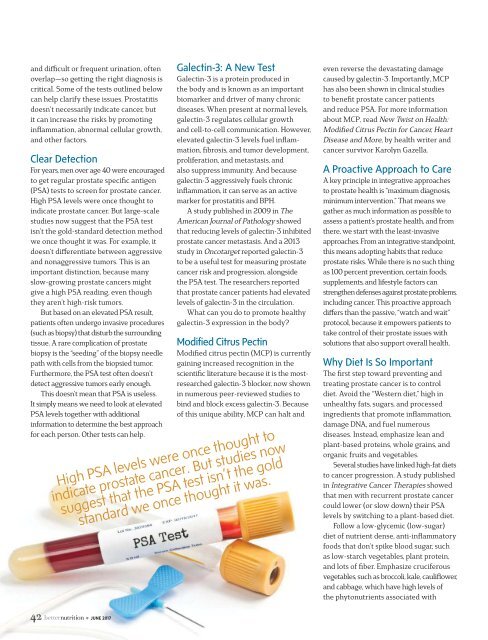Better_Nutrition_June_2017
You also want an ePaper? Increase the reach of your titles
YUMPU automatically turns print PDFs into web optimized ePapers that Google loves.
and difficult or frequent urination, often<br />
overlap—so getting the right diagnosis is<br />
critical. Some of the tests outlined below<br />
can help clarify these issues. Prostatitis<br />
doesn't necessarily indicate cancer, but<br />
it can increase the risks by promoting<br />
inflammation, abnormal cellular growth,<br />
and other factors.<br />
Clear Detection<br />
For years, men over age 40 were encouraged<br />
to get regular prostate specific antigen<br />
(PSA) tests to screen for prostate cancer.<br />
High PSA levels were once thought to<br />
indicate prostate cancer. But large-scale<br />
studies now suggest that the PSA test<br />
isn’t the gold-standard detection method<br />
we once thought it was. For example, it<br />
doesn’t differentiate between aggressive<br />
and nonaggressive tumors. This is an<br />
important distinction, because many<br />
slow-growing prostate cancers might<br />
give a high PSA reading, even though<br />
they aren’t high-risk tumors.<br />
But based on an elevated PSA result,<br />
patients often undergo invasive procedures<br />
(such as biopsy) that disturb the surrounding<br />
tissue. A rare complication of prostate<br />
biopsy is the “seeding” of the biopsy needle<br />
path with cells from the biopsied tumor.<br />
Furthermore, the PSA test often doesn’t<br />
detect aggressive tumors early enough.<br />
This doesn’t mean that PSA is useless.<br />
It simply means we need to look at elevated<br />
PSA levels together with additional<br />
information to determine the best approach<br />
for each person. Other tests can help.<br />
Galectin-3: A New Test<br />
Galectin-3 is a protein produced in<br />
the body and is known as an important<br />
biomarker and driver of many chronic<br />
diseases. When present at normal levels,<br />
galectin-3 regulates cellular growth<br />
and cell-to-cell communication. However,<br />
elevated galectin-3 levels fuel inflammation,<br />
fibrosis, and tumor development,<br />
proliferation, and metastasis, and<br />
also suppress immunity. And because<br />
galectin-3 aggressively fuels chronic<br />
inflammation, it can serve as an active<br />
marker for prostatitis and BPH.<br />
A study published in 2009 in The<br />
American Journal of Pathology showed<br />
that reducing levels of galectin-3 inhibited<br />
prostate cancer metastasis. And a 2013<br />
study in Oncotarget reported galectin-3<br />
to be a useful test for measuring prostate<br />
cancer risk and progression, alongside<br />
the PSA test. The researchers reported<br />
that prostate cancer patients had elevated<br />
levels of galectin-3 in the circulation.<br />
What can you do to promote healthy<br />
galectin-3 expression in the body?<br />
Modified Citrus Pectin<br />
Modified citrus pectin (MCP) is currently<br />
gaining increased recognition in the<br />
scientific literature because it is the mostresearched<br />
galectin-3 blocker, now shown<br />
in numerous peer-reviewed studies to<br />
bind and block excess galectin-3. Because<br />
of this unique ability, MCP can halt and<br />
High PSA levels were once thought to<br />
indicate prostate cancer. But studies now<br />
suggest that the PSA test isn’t the gold<br />
standard we once thought it was.<br />
even reverse the devastating damage<br />
caused by galectin-3. Importantly, MCP<br />
has also been shown in clinical studies<br />
to benefit prostate cancer patients<br />
and reduce PSA. For more information<br />
about MCP, read New Twist on Health:<br />
Modified Citrus Pectin for Cancer, Heart<br />
Disease and More, by health writer and<br />
cancer survivor Karolyn Gazella.<br />
A Proactive Approach to Care<br />
A key principle in integrative approaches<br />
to prostate health is “maximum diagnosis,<br />
minimum intervention.” That means we<br />
gather as much information as possible to<br />
assess a patient’s prostate health, and from<br />
there, we start with the least-invasive<br />
approaches. From an integrative standpoint,<br />
this means adopting habits that reduce<br />
prostate risks. While there is no such thing<br />
as 100 percent prevention, certain foods,<br />
supplements, and lifestyle factors can<br />
strengthen defenses against prostate problems,<br />
including cancer. This proactive approach<br />
differs than the passive, “watch and wait”<br />
protocol, because it empowers patients to<br />
take control of their prostate issues with<br />
solutions that also support overall health.<br />
Why Diet Is So Important<br />
The first step toward preventing and<br />
treating prostate cancer is to control<br />
diet. Avoid the “Western diet,” high in<br />
unhealthy fats, sugars, and processed<br />
ingredients that promote inflammation,<br />
damage DNA, and fuel numerous<br />
diseases. Instead, emphasize lean and<br />
plant-based proteins, whole grains, and<br />
organic fruits and vegetables.<br />
Several studies have linked high-fat diets<br />
to cancer progression. A study published<br />
in Integrative Cancer Therapies showed<br />
that men with recurrent prostate cancer<br />
could lower (or slow down) their PSA<br />
levels by switching to a plant-based diet.<br />
Follow a low-glycemic (low-sugar)<br />
diet of nutrient dense, anti-inflammatory<br />
foods that don’t spike blood sugar, such<br />
as low-starch vegetables, plant protein,<br />
and lots of fiber. Emphasize cruciferous<br />
vegetables, such as broccoli, kale, cauliflower,<br />
and cabbage, which have high levels of<br />
the phytonutrients associated with<br />
!" • JUNE <strong>2017</strong>


















